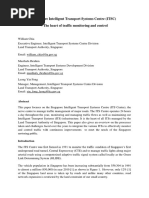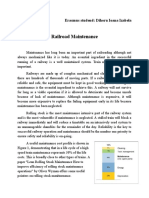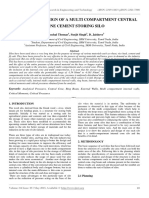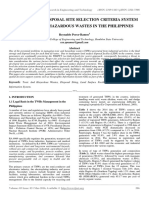Can Protocol Driverless Train Control System
Uploaded by
esatjournalsCan Protocol Driverless Train Control System
Uploaded by
esatjournalsIJRET: International Journal of Research in Engineering and Technology
eISSN: 2319-1163 | pISSN: 2321-7308
CAN PROTOCOL DRIVERLESS TRAIN CONTROL SYSTEM
V. Amala Rani1, T.V. Subha Austalekshmi2
1
Asst Professor, Department of Electronics and Instrumentation, Sathyabama University, Tamilnadu, India
Asst Professor, Department of Electronics and Instrumentation, Sathyabama University, Tamilnadu, India
Abstract
This paper addresses the train running autonomously without any human operators. Provides information to avoid train to train
collisions, over speeding problem, signaling errors and unmanned railway crossing incidents. This afford a way for a passenger to
know the train location, speed and direction in real time from anywhere in India through his mobile phone.CAN protocol interconnect
all the train compartments with embedded network to ensure safety and security of passengers during disasters occurring within
trains such as bomb blasts and fire outbreaks. This make obtainable way for a passenger to know the train location, speed and
direction in real time from anywhere in India through his mobile phone. The CAN node is used to ensure the safety and comfort of the
passengers. It also have audio speakers to inform the passengers about the approaching station and also to provide alert messages
during a crisis situation.
Key Words: mobile phone, CAN protocol
----------------------------------------------------------------------***-----------------------------------------------------------------------1. INTRODUCTION
Generally when we are on railway platform waiting for a train,
eager to know about the current location and expected time of
arrival of train. Now, for this we completely depend on
announcements made by the enquiry staff. At present the
information of the running trains are monitored with the help
of manual monitoring which is not perfect. In this project the
exact location and speed movement of the train can be
monitored in real time basis. This project has been developed
for a train which provides precise location through interactive
mode on mobile phones, laptops, leading to the elimination for
telephone enquiry. The new classification would be more
useful all through winter or foggy endure stipulation as
passenger hardly get in sequence about Passenger trains
because this project use GPS data to monitor trains and offer
genuine time in order about the position of the train to users.
This proposed work aims to design a system that run the train
autonomously without human operators and also provides alert
messages during crisis situation. Here we propose an approach
to achieve efficiently design user friendly for driverless train
control system application especially target at preventing
accidents such as train to train collisions, over speeding
problem, unmanned railway crossing incidents etc.
2. LITERATURE SURVEY
CAN technology is adopt by most automotive industries
nowadays. As per Chuliang the paper presents a virtual
instrument based control system for research and enlargement
of the automotive and railway industries. This resourceful low
rate proficient and realistic arrangement contains the
applications of data acquisition, controller area network
(CAN), harmful engine exhaust emissions reduction, and spot
welding[1]. The system must be proficient to be employed in
various automation industries due to its flexibility. The
detailed applications of the system presented here, addresses
the monitoring of car engine exhaust emissions, CAN
application in reducing car engine exhaust emissions and
monitoring of automotive and railway spot welding. The
disadvantages are the data as of the gas sensors is require to be
collected and compared for each processing. The virtual
control system is used for only three applications such as
DAQ, CAN and harmful engine exhaust emissions reduction.
According to Chuliang, in this paper introduces a built
network for data CAN transmission following the data
acquisition from the necessary temperature sensors mounted
on a car engine and a train bogie in two respective tests[2].
LABVIEW is the only useful software during this network
design based in the lead of the industrial widely use. The
network should be capable to be functional in various
transportation industries suitable to its elasticity, extensibility
and achievability. The disadvantages are separate PCs are
used to operate as DAQ and CAN system for data sharing
instead of using both the system in same PC.By using only
LAN network we can transfer the data from DAQ PC to CAN
PC.More CAN nodes cannot be extended to build a complex
and functional CAN network This article introduce a method
by means of ARM as the main controller and double gateway
in a control computer in a car[3]. This system make use of the
high presentation of ARM, high speed reduction of CAN bus
communication control networks and instrument control as a
result as to get full sharing of data between nodes and improve
their collaborative work. This system features efficient data
transfer among different nodes in the practical applications.
The system leads to easy data sharing but it is done between
different control systems[4]. The process maintenance is hard
to carry out. The electric system uses a single point to point
__________________________________________________________________________________________
Volume: 03 Issue: 05 | May-2014, Available @ http://www.ijret.org
636
IJRET: International Journal of Research in Engineering and Technology
communication approach which results in large cabling
problem.
3. EXISTING SYSTEM
RAIL RADAR is the new technology launched by Indian
Railways recently, which updates train position on a map
every time it crosses a station on its way. This system does not
provide real-time tracking since each station is located at least
1 km apart in cities and 10-20 km apart in remote places. It
does not use GPS which is a major drawback because the train
location is virtually unknown until it reaches the next station
that may be 5 to 20 minutes away. HUMAN ERROR is one of
the major reasons for train accidents. Every year we end up
with at least 2 or 3 major train accidents purely based on
human errors. Train to train collisions, over speeding trains
and signaling errors are typical cases where hundreds of lives
have been lost. Most of the time the reason would be on errors
from drivers and signal operators. Another important problem
is SAFETY AND SECURITY of passengers within trains.
Terrorist organizations want to make the country unsafe and
one of their ways is to plant bombs and explosives in of lives.
The driver has got no way to know the happenings trains.
Although security is available in railway stations, it is still not
enough to prevent such attacks. Also, we hear news such as
fire outbreak that originated in one compartment that quickly
spread to other part of the trains resulting in loss of huge
number behind the engine. Lives are also lost when
people/vehicles try to cross the tracks without noticing an
approaching train. Human error is one of the major reasons for
train accidents. The onboard passengers are not able to know
the approaching station
eISSN: 2319-1163 | pISSN: 2321-7308
The onboard disaster prevention network connects all the
compartments of the train with the main control node over
CAN bus (Controller Area Network). CAN is a networking
protocol widely used in automotive applications to
interconnect different parts of the vehicle. It is also being used
in industrial automation networks. In unmanned railway
crossings, truck/car/humans/animals may cross a railway line.
The train control system oversees this and can adapt to slow
down the speed accordingly. This overrides the speed setting
from the server. It has a front SONAR ultrasonic range finder
for this purpose. The advantages are (i) a passenger can query
the location of a train via SMS. (ii) Accuracy of GPS location
is very high. (iii) Centrally controlled route server. (iv)
automatic speed adjustment
5. BLOCK DIAGRAM
4. PROPOSED SYSTEM
Driverless train control system operates on the principle of a
central railway server and communication devices fixed in
each trains. All the trains on that particular route will update
the central railway server with their location, speed and
direction information. The train unit has an onboard GPS
module and a GSM module. A passenger can simply query the
location of a train via SMS from his mobile phone. The train
unit will reply to the user mobile with the GPS coordinates of
the present location it is traveling The server collects all such
information, calculates the optimum speed of travel for each
train and sends this information to those trains on the route.
The train control system will send its present GPS location
information periodically (typically every 30 sec) to the central
railway server. This message will immediately be
acknowledged with a reply message from the server that will
indicate the speed to travel. The train control system will
automatically adjust its speed to the speed indicated by the
server. The railway server is a software application that will be
running on a secured PC environment.
It has a front SONAR ultrasonic range finder to check any
truck/car/humans/animals crossing a railway line and the train
control system oversees this and can adapt to slow down the
speed accordingly for this purpose.The onboard disaster
prevention network connects all the compartments of the train
with the main control node over CAN bus (Controller Area
Network). Each CAN node has got a variety of sensors and
devices to ensure the safety and comfort of the passengers.
The LPC11C14 are ARM cortex-M0 based microcontrollers
for embedded applications feature a high level of integration
and low power consumption. The train unit have an onboard
GPS and GSM module. The train control system send its
present GPS location information at times to the central
railway server. By using SONAR, we know how to detect the
obstacles and lessen the severity of accidents. The onboard
disaster prevention network connects all the compartments of
__________________________________________________________________________________________
Volume: 03 Issue: 05 | May-2014, Available @ http://www.ijret.org
637
IJRET: International Journal of Research in Engineering and Technology
the train with the main control node over CAN bus. Metal
detector sensor detects explosives by sensing the variations in
the magnetic field around it. A digital MEMS magnetometer is
used for this. Temperature sensor detects fire outbreaks by
sensing large temperature variations.
eISSN: 2319-1163 | pISSN: 2321-7308
sensing large temperature variations. Audio announcement
system is designed to announce the approaching station names
found out via GPS location. This is also used to update critical
emergency information with the passengers such as fire
outbreak. Emergency push button to stop the train in critical
situation The mp3 audio files are stored in an external 2-GB
MicroSD memory card and an MP3 Decoder chip is used to
play it in speaker. The microcontroller is able to access the
files in memory card via a FAT-32 file system library.
6. RESULTS AND CONCLUSIONS
It has a front SONAR ultrasonic range finder to check any
truck/car/humans/animals crossing a railway line and the train
control system oversees this and can adapt to slow down the
speed accordingly for this purpose. The onboard disaster
prevention network connects all the compartments of the train
with the main control node over CAN bus (Controller Area
Network). Each CAN node has got a variety of sensors and
devices to ensure the safety and comfort of the passengers.
The LPC11C14 are ARM cortex-M0 based microcontrollers
for embedded applications feature a high level of integration
and low power consumption. The train unit have an onboard
GPS and GSM module. The train control system send its
present GPS location information at times to the central
railway server. By using SONAR, we know how to detect the
obstacles and lessen the severity of accidents. The onboard
disaster prevention network connects all the compartments of
the train with the main control node over CAN bus. Metal
detector sensor detects explosives by sensing the variations in
the magnetic field around it. A digital MEMS magnetometer is
used for this. Temperature sensor detects fire outbreaks by
A passenger can get the location of a train via SMS from his
mobile phone in the form of longitudinal and latitudinal of the
train location. The message displays the Train location
longitude=25.32 and latitude=45.65 on the screen. All the
trains on that particular route will update the central railway
server with their location, speed and direction information.
The train control system will send its present GPS location
information periodically (typically every 30 sec) to the central
railway server. The train control system will automatically
adjust its speed to the speed indicated by the server. In
unmanned railway crossings, truck/car/humans/animals may
cross a railway line. The train control system considers this
and slow down the speed accordingly. In that case the message
is Obstacle detected. Latitude=41.32 and longitude=21.87.
Incase of any fire outbreaks in any compartment in train, the
buzzer alert is given to other compartment and an alert
message is send to central server and the train speed is
controlled. The message will be Fire detected in coach 1.
Latitude=41.32 and longitude=21.87 Incase some explosive
element is detected in any compartment of train, the buzzer
alert is given to other compartment and an alert message is
send to central server. The message will be Explosive metal
detected in coach 2. Latitude=41.32 and longitude=21.87 .In
some emergency case, the emergency switch is pressed then
the message is send to central server and the train get
controlled by stopping it. The messages will be Emergency
detected in coach 2. Latitude=41.32 and longitude=21.87
The project uses GPS data to monitor trains and offer real time
information about the location of train to users. All the trains
are monitored by a navigation system which is totally satellite
based. At present the information of the running trains are
monitored with the help of manual monitoring which is not
perfect but with the help of this project the movement of the
trains are recorded, which will also include the correct place
and speed in real time basis. Passengers can also be available
to see real time locations, as Centre of Railway Information
System (CRIS) has integrated the GPS application with
Google maps. INSAT-3C satellite will aid in location of
moving trains. The GPS system is being capable of give an
accuracy of about 10 meters, with a lag of about 2 minutes By
using this project, the controller will only plan the running and
scheduling of trains instead of co-ordination with various
other stations to confirm the status of the trains.
__________________________________________________________________________________________
Volume: 03 Issue: 05 | May-2014, Available @ http://www.ijret.org
638
IJRET: International Journal of Research in Engineering and Technology
eISSN: 2319-1163 | pISSN: 2321-7308
REFERENCES
[1]. Chuliang Wei and Zhemin Zhuang, A.I.AlShammaa,A.Shaw, Hwa-yaw Tam and S.L Ho, Avirtual
control system for automotive and railway industries
Intelligent Computation Technology and Automation
(ICICTA), 2011 International Conference on (Volume:1 )
978-1-61284-289- 28-29 March 2011 P580 583.
[2]. Chuliang Wei and Zhemin Zhuang(2011). A CAN
Network For Temperature Monitoring of Car Engine and
Train Bogieproceeding on International conference on
internet computing and information services. 978-1-45771561-7, 17th to 18th Sep 2011, p. 302-305.
[3]. Jufang Hu, Chunru Xiong : Study on the embedded CAN
bus control system in the vehicle proceeding on International
conference on computer science and electronics engineering
2012, 978-1-4673-0689-8,. p. 440-442-305.
[4]. Li,s.; Wu,Y.;Li,g.;Zhu,Y. , Continuous and real time data
acquisition embedded system for EAST, proceeding on 16TH
IEEE-NPSS Real Time Conference 2009, 978-1-4244-4454-0,
10-15 May 2009, P499-502.
APPENDICES
__________________________________________________________________________________________
Volume: 03 Issue: 05 | May-2014, Available @ http://www.ijret.org
639
You might also like
- Whitepaper India Telematics Ecosystem Trends Adoption CORE BenchmarkingNo ratings yetWhitepaper India Telematics Ecosystem Trends Adoption CORE Benchmarking23 pages
- Paper - Singapore ITSC The Heart of Traffic Monitoring & Control100% (1)Paper - Singapore ITSC The Heart of Traffic Monitoring & Control7 pages
- Kavach: Cab Signalling & Automatic Train Protection System for Digital RailwaysFrom EverandKavach: Cab Signalling & Automatic Train Protection System for Digital RailwaysNo ratings yet
- Intelligent Transport Systems (ITS) Cooperative ITS (C-ITS) Release 1 Communications ArchitectureNo ratings yetIntelligent Transport Systems (ITS) Cooperative ITS (C-ITS) Release 1 Communications Architecture44 pages
- Design and Fabrication of Automatic Railway Track Crack Detection System100% (1)Design and Fabrication of Automatic Railway Track Crack Detection System6 pages
- Railway Track Monitoring System: Abstract - The Main Problem Is About Railway Track CrackNo ratings yetRailway Track Monitoring System: Abstract - The Main Problem Is About Railway Track Crack3 pages
- Railway Intelligent Transportation System Architecture and Implementation Viliam LENDEL Michal VARMUS10% (1)Railway Intelligent Transportation System Architecture and Implementation Viliam LENDEL Michal VARMUS114 pages
- 3.04 Hirao - Safety Technology of Railway SignallingNo ratings yet3.04 Hirao - Safety Technology of Railway Signalling9 pages
- SMS Based Home Automation Using CAN Protocol100% (1)SMS Based Home Automation Using CAN Protocol6 pages
- DBI2021 - Group 2 Consumerization of TransportationNo ratings yetDBI2021 - Group 2 Consumerization of Transportation38 pages
- Agency Report To The Commission - Evolution of Railway Radio Communication - System DefinitionNo ratings yetAgency Report To The Commission - Evolution of Railway Radio Communication - System Definition31 pages
- Railroad Maintenance: Erasmus Studend: Dihoru Ioana IzabelaNo ratings yetRailroad Maintenance: Erasmus Studend: Dihoru Ioana Izabela12 pages
- Handbook On DevelopmentBuilding Works in RailwayProtectionZone PDFNo ratings yetHandbook On DevelopmentBuilding Works in RailwayProtectionZone PDF108 pages
- Independent Safety Assessment (ISA) of Railway Systems - TÜV SÜD - TÜV SÜDNo ratings yetIndependent Safety Assessment (ISA) of Railway Systems - TÜV SÜD - TÜV SÜD8 pages
- FuseAutoChangeOver RDSO SPN 209 2012 VER 2100% (1)FuseAutoChangeOver RDSO SPN 209 2012 VER 217 pages
- Assessment of Turnout-Related Derailments by Various CausesNo ratings yetAssessment of Turnout-Related Derailments by Various Causes13 pages
- PLC Based Traffic Control System With Emergency Vehicle Detection and ManagementNo ratings yetPLC Based Traffic Control System With Emergency Vehicle Detection and Management7 pages
- Background Information On Automatic Train Operation (Ato) and Grades of Automation (Goa) For Smartrail 4.0No ratings yetBackground Information On Automatic Train Operation (Ato) and Grades of Automation (Goa) For Smartrail 4.02 pages
- Assessment and Improvement of Railway Track SafetyNo ratings yetAssessment and Improvement of Railway Track Safety8 pages
- Dependability of Railway Control & Communications Systems v2100% (2)Dependability of Railway Control & Communications Systems v228 pages
- Intelligent Transportation System - Wikipedia100% (1)Intelligent Transportation System - Wikipedia9 pages
- 1 Appendix Functional Tests For SW-FAT Westrace MK2 - DocxNo ratings yet1 Appendix Functional Tests For SW-FAT Westrace MK2 - Docx16 pages
- Automated Metro - Ensuring Safety and Reliability With Minimum Human InterventionNo ratings yetAutomated Metro - Ensuring Safety and Reliability With Minimum Human Intervention10 pages
- Reliability Analysis of Switches and Crossings 2013 v1.4No ratings yetReliability Analysis of Switches and Crossings 2013 v1.430 pages
- Internet of Things Architecture - Recent Advances, Taxonomy, Requirements, and Open ChallengesNo ratings yetInternet of Things Architecture - Recent Advances, Taxonomy, Requirements, and Open Challenges15 pages
- Rail Systems Business Strategy: Hiroshi NakayamaNo ratings yetRail Systems Business Strategy: Hiroshi Nakayama28 pages
- GE Incremental Train Control System (ITCS)No ratings yetGE Incremental Train Control System (ITCS)2 pages
- 2017 01 27 Rail Technical Strategy Capability Delivery Plan BrochureNo ratings yet2017 01 27 Rail Technical Strategy Capability Delivery Plan Brochure40 pages
- Can Protocol Driverless Train Control SystemNo ratings yetCan Protocol Driverless Train Control System4 pages
- Automotive Railway Protection & Info SystemNo ratings yetAutomotive Railway Protection & Info System10 pages
- Motor Speed Control Based On Temperature Using Can ProtocolNo ratings yetMotor Speed Control Based On Temperature Using Can Protocol4 pages
- A Review Paper On Smart Health Care System Using Internet of ThingsNo ratings yetA Review Paper On Smart Health Care System Using Internet of Things5 pages
- Analysis of Cylindrical Shell Structure With Varying Parameters PDFNo ratings yetAnalysis of Cylindrical Shell Structure With Varying Parameters PDF6 pages
- Analysis and Optimization of Electrodes For Improving The Performance of Ring Laser Gyro PDFNo ratings yetAnalysis and Optimization of Electrodes For Improving The Performance of Ring Laser Gyro PDF4 pages
- Analysis and Design of A Multi Compartment Central Cone Cement Storing Silo PDFNo ratings yetAnalysis and Design of A Multi Compartment Central Cone Cement Storing Silo PDF7 pages
- A Research On Significance of Kalman Filter-Approach As Applied in Electrical Power SystemNo ratings yetA Research On Significance of Kalman Filter-Approach As Applied in Electrical Power System8 pages
- A Study and Survey On Various Progressive Duplicate Detection MechanismsNo ratings yetA Study and Survey On Various Progressive Duplicate Detection Mechanisms3 pages
- A Servey On Wireless Mesh Networking ModuleNo ratings yetA Servey On Wireless Mesh Networking Module5 pages
- A Survey On Identification of Ranking Fraud For Mobile ApplicationsNo ratings yetA Survey On Identification of Ranking Fraud For Mobile Applications6 pages
- A Review Paper On Smart Health Care System Using Internet of ThingsNo ratings yetA Review Paper On Smart Health Care System Using Internet of Things5 pages
- Pushover Analysis-To Study Seismic Performances of Vertical Irregular Structure PDFNo ratings yetPushover Analysis-To Study Seismic Performances of Vertical Irregular Structure PDF4 pages
- A Servey On Wireless Mesh Networking ModuleNo ratings yetA Servey On Wireless Mesh Networking Module5 pages
- A Three-Level Disposal Site Selection Criteria System For Toxic and Hazardous Wastes in The PhilippinesNo ratings yetA Three-Level Disposal Site Selection Criteria System For Toxic and Hazardous Wastes in The Philippines9 pages
- Power Generation Using Maglev Windmill PDFNo ratings yetPower Generation Using Maglev Windmill PDF6 pages
- A Review On Fake Biometric Detection System For Various ApplicationsNo ratings yetA Review On Fake Biometric Detection System For Various Applications4 pages
- A Study and Survey On Various Progressive Duplicate Detection MechanismsNo ratings yetA Study and Survey On Various Progressive Duplicate Detection Mechanisms3 pages
- A Research On Significance of Kalman Filter-Approach As Applied in Electrical Power SystemNo ratings yetA Research On Significance of Kalman Filter-Approach As Applied in Electrical Power System8 pages
- A Women Secure Mobile App For Emergency Usage (Go Safe App)No ratings yetA Women Secure Mobile App For Emergency Usage (Go Safe App)3 pages
- Privacy Preserving Through Mediator in Decentralized Ciphertext Policy Attribute Based Encryption PDFNo ratings yetPrivacy Preserving Through Mediator in Decentralized Ciphertext Policy Attribute Based Encryption PDF6 pages
- Iot-Aided Charity: An Excess Food Redistribution Framework: Abstract - A Trusted and Active Community Aided andNo ratings yetIot-Aided Charity: An Excess Food Redistribution Framework: Abstract - A Trusted and Active Community Aided and6 pages
- Cognitive Control and Flexibility in The Context of Stress and Depressive Symptoms The Cognitive Control and Flexibility Questionnaire100% (1)Cognitive Control and Flexibility in The Context of Stress and Depressive Symptoms The Cognitive Control and Flexibility Questionnaire19 pages
- Bioethics (Ngcm108) : Rolando de Guzman Iii RN, RM, Man, Dsped Instructor50% (2)Bioethics (Ngcm108) : Rolando de Guzman Iii RN, RM, Man, Dsped Instructor55 pages
- Three Norwegian Brothers All European 1500 M Champions - What Is The SecretNo ratings yetThree Norwegian Brothers All European 1500 M Champions - What Is The Secret7 pages
- Catalogue Hanjayaperkasa Metals IndonesiaNo ratings yetCatalogue Hanjayaperkasa Metals Indonesia76 pages
- Whitepaper India Telematics Ecosystem Trends Adoption CORE BenchmarkingWhitepaper India Telematics Ecosystem Trends Adoption CORE Benchmarking
- Paper - Singapore ITSC The Heart of Traffic Monitoring & ControlPaper - Singapore ITSC The Heart of Traffic Monitoring & Control
- Kavach: Cab Signalling & Automatic Train Protection System for Digital RailwaysFrom EverandKavach: Cab Signalling & Automatic Train Protection System for Digital Railways
- Intelligent Transport Systems (ITS) Cooperative ITS (C-ITS) Release 1 Communications ArchitectureIntelligent Transport Systems (ITS) Cooperative ITS (C-ITS) Release 1 Communications Architecture
- Design and Fabrication of Automatic Railway Track Crack Detection SystemDesign and Fabrication of Automatic Railway Track Crack Detection System
- Railway Track Monitoring System: Abstract - The Main Problem Is About Railway Track CrackRailway Track Monitoring System: Abstract - The Main Problem Is About Railway Track Crack
- Railway Intelligent Transportation System Architecture and Implementation Viliam LENDEL Michal VARMUS1Railway Intelligent Transportation System Architecture and Implementation Viliam LENDEL Michal VARMUS1
- 3.04 Hirao - Safety Technology of Railway Signalling3.04 Hirao - Safety Technology of Railway Signalling
- DBI2021 - Group 2 Consumerization of TransportationDBI2021 - Group 2 Consumerization of Transportation
- Agency Report To The Commission - Evolution of Railway Radio Communication - System DefinitionAgency Report To The Commission - Evolution of Railway Radio Communication - System Definition
- Railroad Maintenance: Erasmus Studend: Dihoru Ioana IzabelaRailroad Maintenance: Erasmus Studend: Dihoru Ioana Izabela
- Handbook On DevelopmentBuilding Works in RailwayProtectionZone PDFHandbook On DevelopmentBuilding Works in RailwayProtectionZone PDF
- Independent Safety Assessment (ISA) of Railway Systems - TÜV SÜD - TÜV SÜDIndependent Safety Assessment (ISA) of Railway Systems - TÜV SÜD - TÜV SÜD
- Assessment of Turnout-Related Derailments by Various CausesAssessment of Turnout-Related Derailments by Various Causes
- PLC Based Traffic Control System With Emergency Vehicle Detection and ManagementPLC Based Traffic Control System With Emergency Vehicle Detection and Management
- Background Information On Automatic Train Operation (Ato) and Grades of Automation (Goa) For Smartrail 4.0Background Information On Automatic Train Operation (Ato) and Grades of Automation (Goa) For Smartrail 4.0
- Assessment and Improvement of Railway Track SafetyAssessment and Improvement of Railway Track Safety
- Dependability of Railway Control & Communications Systems v2Dependability of Railway Control & Communications Systems v2
- 1 Appendix Functional Tests For SW-FAT Westrace MK2 - Docx1 Appendix Functional Tests For SW-FAT Westrace MK2 - Docx
- Automated Metro - Ensuring Safety and Reliability With Minimum Human InterventionAutomated Metro - Ensuring Safety and Reliability With Minimum Human Intervention
- Reliability Analysis of Switches and Crossings 2013 v1.4Reliability Analysis of Switches and Crossings 2013 v1.4
- Internet of Things Architecture - Recent Advances, Taxonomy, Requirements, and Open ChallengesInternet of Things Architecture - Recent Advances, Taxonomy, Requirements, and Open Challenges
- 2017 01 27 Rail Technical Strategy Capability Delivery Plan Brochure2017 01 27 Rail Technical Strategy Capability Delivery Plan Brochure
- Railroad Accidents Their Cause and PreventionFrom EverandRailroad Accidents Their Cause and Prevention
- Motor Speed Control Based On Temperature Using Can ProtocolMotor Speed Control Based On Temperature Using Can Protocol
- A Review Paper On Smart Health Care System Using Internet of ThingsA Review Paper On Smart Health Care System Using Internet of Things
- Analysis of Cylindrical Shell Structure With Varying Parameters PDFAnalysis of Cylindrical Shell Structure With Varying Parameters PDF
- Analysis and Optimization of Electrodes For Improving The Performance of Ring Laser Gyro PDFAnalysis and Optimization of Electrodes For Improving The Performance of Ring Laser Gyro PDF
- Analysis and Design of A Multi Compartment Central Cone Cement Storing Silo PDFAnalysis and Design of A Multi Compartment Central Cone Cement Storing Silo PDF
- A Research On Significance of Kalman Filter-Approach As Applied in Electrical Power SystemA Research On Significance of Kalman Filter-Approach As Applied in Electrical Power System
- A Study and Survey On Various Progressive Duplicate Detection MechanismsA Study and Survey On Various Progressive Duplicate Detection Mechanisms
- A Survey On Identification of Ranking Fraud For Mobile ApplicationsA Survey On Identification of Ranking Fraud For Mobile Applications
- A Review Paper On Smart Health Care System Using Internet of ThingsA Review Paper On Smart Health Care System Using Internet of Things
- Pushover Analysis-To Study Seismic Performances of Vertical Irregular Structure PDFPushover Analysis-To Study Seismic Performances of Vertical Irregular Structure PDF
- A Three-Level Disposal Site Selection Criteria System For Toxic and Hazardous Wastes in The PhilippinesA Three-Level Disposal Site Selection Criteria System For Toxic and Hazardous Wastes in The Philippines
- A Review On Fake Biometric Detection System For Various ApplicationsA Review On Fake Biometric Detection System For Various Applications
- A Study and Survey On Various Progressive Duplicate Detection MechanismsA Study and Survey On Various Progressive Duplicate Detection Mechanisms
- A Research On Significance of Kalman Filter-Approach As Applied in Electrical Power SystemA Research On Significance of Kalman Filter-Approach As Applied in Electrical Power System
- A Women Secure Mobile App For Emergency Usage (Go Safe App)A Women Secure Mobile App For Emergency Usage (Go Safe App)
- Privacy Preserving Through Mediator in Decentralized Ciphertext Policy Attribute Based Encryption PDFPrivacy Preserving Through Mediator in Decentralized Ciphertext Policy Attribute Based Encryption PDF
- Iot-Aided Charity: An Excess Food Redistribution Framework: Abstract - A Trusted and Active Community Aided andIot-Aided Charity: An Excess Food Redistribution Framework: Abstract - A Trusted and Active Community Aided and
- Cognitive Control and Flexibility in The Context of Stress and Depressive Symptoms The Cognitive Control and Flexibility QuestionnaireCognitive Control and Flexibility in The Context of Stress and Depressive Symptoms The Cognitive Control and Flexibility Questionnaire
- Bioethics (Ngcm108) : Rolando de Guzman Iii RN, RM, Man, Dsped InstructorBioethics (Ngcm108) : Rolando de Guzman Iii RN, RM, Man, Dsped Instructor
- Three Norwegian Brothers All European 1500 M Champions - What Is The SecretThree Norwegian Brothers All European 1500 M Champions - What Is The Secret









































































































